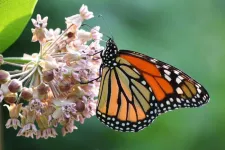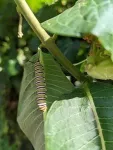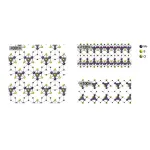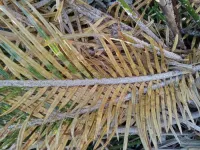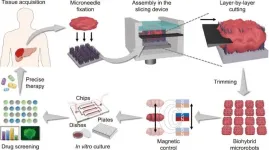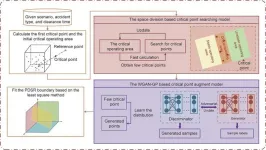(Press-News.org) Monarch butterflies, with their striking orange and black wings, are some of the most recognizable butterflies in North America. But they're in trouble. Monarch caterpillars can only eat the leaves of milkweed, a native wildflower. As milkweed has disappeared, so have the monarchs, to the point that they're at risk of extinction. Research shows that planting milkweed in home gardens can add significant monarch habitat to the landscape. In a new study in the journal Frontiers in Ecology and Evolution, researchers and community scientists monitored urban milkweed plants for butterfly eggs to learn what makes these city gardens more hospitable to monarchs. They found that even tiny city gardens attracted monarchs and became a home to caterpillars.
“In this study, we found that monarchs can find the milkweed, wherever the milkweed is, even if it’s in planters on balconies and rooftops,” says Karen Klinger, a Geographic Information Systems analyst in the Keller Science Action Center at the Field Museum and the study’s lead author. “Milkweed gardens can be in all shapes and sizes, and any milkweed garden can contribute habitat for monarchs.”
Monarch butterflies have one of the most unusual and demanding migration patterns of any insect. The eastern population of monarchs starts the year in Mexico, and they move up across North America in the spring and summer. “As they travel, they lay their eggs, and when those adults die, the next generation continues the migration northward. They will make it all the way to southern Canada, and at the end of summer, a new super generation is born that migrates all the way south and survives through the winter,” says Klinger.
Since it takes multiple generations of milkweed-eating caterpillars to get the monarch population from Mexico to Canada each year, the monarchs rely on milkweed plants throughout their migration path. “There used to be wild milkweed growing along farmland in the Midwest, but now farmers use pesticides that kill the milkweed. As a result, a lot of the habitat for monarchs in the Midwest has disappeared,” says Klinger.
Monarch populations have declined along with the disappearance of milkweed; in recent years, they’ve been a candidate for endangered species status by the International Union for Conservation of Nature and the US Fish and Wildlife Service. “ If we don’t do anything soon, monarchs are going to be in serious trouble,” says Aster Hasle, a lead conservation ecologist at the Field Museum’s Keller Science Action Center and a co-author of the paper.
Since so much of the rural milkweed that monarchs used to rely on has disappeared, scientists have wondered if milkweed gardens in urban areas might be able to bridge the gap. “There was a call for all hands on deck, to plant milkweed across all sectors of the landscape, but people discounted urban areas, because if you look at some mapping of urban areas, it looks like it’s completely developed, with no availability for milkweed plants,” says Klinger.
Klinger was a co-author of a 2019 study led by Field Museum scientists that showed that even “concrete jungles” have room for milkweed plants, in people’s yards, alleyways, and rooftops.
The new study led by Klinger is a follow-up to this earlier work. “With our 2019 study, we found that a lot of the spaces where milkweed could grow was inaccessible to scientists-- we couldn't go into people's backyards, and look at their milkweed, so there was a lot of milkweed that we can't account for,” says Klinger. “But we also found that there was a lot of enthusiasm among residents to plant milkweed and support monarchs. So based on that, we did a community science project that became the basis of this new paper.”
Klinger and Hasle worked with volunteers around Chicagoland to monitor milkweed plants in their yards and neighborhoods for monarch butterflies laying their eggs on the plants and caterpillars eating the milkweed leaves.
“We wanted to answer the question of, how well do these urban milkweed gardens actually support monarch butterflies? Everybody always wants to know, what should I plant? What species of milkweed, how many plants, how big of a garden? There are so many questions to answer, so we were hoping that we could use this project and the data from it to start answering those questions.”
Klinger and Hasle trained over 400 community scientist volunteers on how to monitor their milkweed for monarch eggs and caterpillars, which they reported back to the researchers. Over the course of four years, the team collected 5,905 observations of monarch activity on 810 patches of milkweed in Chicagoland. This paper analyzed a portion of this data from 2020-2022.
“We encouraged participants who had planters on balconies, who had planters on rooftop decks, and we saw some of the most amazing things,” says Klinger. “There was one participant who had a planter set on the condominium roof that had five large caterpillars in one photo.”
Based on these observations, the researchers found several overarching trends about what makes for a successful milkweed garden. “There are several native species of milkweed, and we found that common milkweed was very prevalent in people’s gardens and was really key, both in terms of whether monarchs laid their eggs there, and how many they laid,” says Klinger. “Also, kind of surprisingly, that older, more established milkweed plants did a lot better, they were more likely to see eggs than younger plants.” In addition, having a variety of blooming plants was also key for monarchs to lay more eggs on milkweed, as it provided lots of nectar for the adults.
However, while a garden with lots of native milkweed and other flowering plants left to grow year after year might be the best way to help monarchs, the researchers noted that every little bit helps. “Plant the species that works the best for you and your garden,” says Klinger. As of July 24, 2024, Illinois Governor JB Pritzker signed into law the Mobilizing Our Neighborhoods to Adopt Resilient Conservation Habitats (MONARCH) Act, which restricts HOAs from prohibiting native plantings and provides financial and technical assistance for establishing native and pollinator-friendly gardens.
While monarchs are just one small species of insect, they're indicative of the big-picture health of the ecosystems they live in. “Because they cross this big landscape from Mexico to Canada, monarchs are an important indicator of what's happening across a big area,” says Hasle. “Monarchs need a lot of the things that other insects need, like blooming flowers, so what’s good for monarchs is good for other pollinators too. And we’re in the midst of a global insect decline, so it’s important to help.”
###
END
Monarch butterflies need help, and a little bit of milkweed goes a long way
2024-07-31
ELSE PRESS RELEASES FROM THIS DATE:
Newly discovered sheets of nanoscale “cubes” make excellent catalysts
2024-07-31
Tokyo, Japan – Researchers from Tokyo Metropolitan University have created sheets of transition metal chalcogenide “cubes” connected by chlorine atoms. While sheets of atoms have been widely studied e.g. graphene, the team’s work breaks new ground by using clusters instead. The team succeeded in forming nanoribbons inside carbon nanotubes for structural characterization, while also forming microscale sheets of cubes which could be exfoliated and probed. These were shown to be an excellent catalyst for generating hydrogen.
Two-dimensional materials are a breakthrough in nanotechnology, realizing ...
Keck Hospital of USC earns five stars on CMS 2024 quality star rating report for second year in a row
2024-07-31
LOS ANGELES — Keck Hospital of USC earned five stars, the highest rating possible, on the Centers for Medicare & Medicaid Services (CMS) 2024 quality star rating report. This is the second year in a row the hospital has received five stars.
Only approximately 16% of hospitals across the country, 483 out of 3,076, received five stars out of a one-to-five-star rating system.
“Receiving this prestigious recognition for the second time in a row validates the hospital’s continuous commitment to patient safety and best patient outcomes and is a testament to the dedication and hard ...
Breakthrough in high-performance computing and quantum chemistry revolutionises drug discovery
2024-07-31
Led by University of Melbourne theoretician and HPC expert Associate Professor Giuseppe Barca, a research team has achieved the first quantum simulation of biological systems at a scale necessary to accurately model drug performance.
Utilising the unprecedented “exascale” power of the Frontier supercomputer at the Oak Ridge Leadership Computing Facility in Tennessee, US, the team has developed groundbreaking software capable of accurately predicting the chemical reactions and physical properties of molecular systems comprising ...
Invasive insect herbivore alters ecosystem services delivered by cycads
2024-07-31
A study published in the June 2024 issue of the journal Pedosphere looks at how a non-native armored scale insect alters the leaf litter decomposition dynamics of the novel host cycad species in newly invaded islands. The scale insect, known as cycad aulacaspis scale, or CAS, has been invading new territories around the globe for decades, killing the resident cultivated and natural cycad populations.
Non-native insect herbivores that invade island communities often threaten native plants that serve as newly discovered hosts. The scientific community often quantifies plant ...
Innovative tissue analysis: Pioneering controllable histotomy with magnetic microneedle array robots
2024-07-31
In a pioneering development for the biomedical field, a research team led by Yuanjin Zhao from Nanjing Drum Tower Hospital, China, has published a research article in Engineering. The article, titled “Controllable Histotomy Based on Hierarchical Magnetic Microneedle Array Robots,” introduces a novel technique for tissue slicing and cultivation that could revolutionize the way primary tissues are handled in clinical settings.
The in vitro cultivation of patient-derived tissues is crucial for accurate diagnosis, precision medication, individualized therapy, and tissue engineering. However, current tissue slicing and cultivation techniques often fall ...
Ammonia-free gallium nitride semiconductor production improves crystal quality and reduces environmental impact
2024-07-31
Gallium nitride (GaN) semiconductors can now be grown without ammonia, a toxic chemical that needs a sophisticated detoxifying system before it can be released into the atmosphere. The new technique is not only more environmentally friendly but also allows for the efficient and high-quality growth of crystals at a lower cost. Scientists can make semiconductors more efficiently with a reduced need for raw materials and power. Researchers from Nagoya University in Japan led the study, which was published in Scientific Reports.
GaN is a compound made up of gallium (Ga) and nitrogen ...
Enhancing power system stability: Tianjin University unveils a groundbreaking method for rapid generation of dynamic security region boundaries
2024-07-31
Fast and accurate transient stability analysis is crucial to power system operation. With high penetration level of wind power resources, practical dynamic security region (PDSR) with hyper plane expression has outstanding advantages in situational awareness and series of optimization problems. The precondition of obtaining accurate PDSR boundary is to locate sufficient points around the boundary (critical points). Therefore, a research team led by Yanli Liu from Tianjin University, China, has developed a space division and Wasserstein generative adversarial network with gradient penalty (WGAN-GP) based fast generation method of PDSR boundary. The study, published in Engineering.
The ...
New report shows greater interest in labor unions, especially among young workers
2024-07-31
A new report from the University of California San Diego School of Global Policy and Strategy reveals significant changes in support for labor unions among U.S. workers.
The report, published by the Economics Policy Institute, delves into the evolving attitudes toward unions and identifies three major shifts are occurring in U.S. workers: a recent, marked decline in opposition to labor unions, a rise of workers who are interested in—but unsure about—unions and an emerging generation gap in attitudes toward unionization between younger and older workers.
“While we compared levels of support for workplace unionization ...
Better medication management needed for older hospital patients
2024-07-31
Ensuring older hospital patients receive specialised medication management could reduce their stay in hospital and potentially lower their risk of death, according to new research conducted by Flinders University in collaboration with Flinders Medical Centre.
One in ten older people experience ‘adverse drug reactions’ (ADRs) to medications whilst in hospital, the research published in The Journal of the American Medical Directors Association (JAMDA) found.
“As the population is getting older, patients have more chronic medical ...
Ochsner Health selects DeepScribe to bring ambient AI to clinicians
2024-07-31
New Orleans, LA - July 30, 2024 – Ochsner Health announces an enterprise-wide agreement with DeepScribe to implement its ambient AI clinical documentation technology across its 46 hospitals and 370 health and urgent care centers. DeepScribe ambient AI turns each patient conversation into a complete, accurate note with real-time insights for clinicians, empowering them to be fully present with the patient while helping health systems achieve quality and value-based goals.
Ochsner clinicians participating during the pilot phase have already seen a positive effect on the patient experience, with 96 percent of their patients stating they are likely to recommend ...
